The basics of coffee beans
Coffee belongs to the evergreen shrub of the genus Rubiaceae, which is centered in the tropics. There are about 6000 species of Rubiaceae belonging to 500 genera. Coffee has always been thought to have certain effects, such as strengthening the stomach, waking up the brain, stopping bleeding, dissipating heat, strengthening the body, and so on. The more famous Rubiaceae plant is Gardenia jasminoides, whose fruit was dried and used as medicinal material a long time ago.
Three native species of coffee
There are about 40 species of coffee plants, but the only ones that can produce coffee beans of commercial value are Arabica, Robusta and Liberian. these three species are called the "three native species of coffee".
1. Arabica species (scientific name Coffea arabica)
The origin of the Arabica species is the Abyssinia Plateau of Ethiopia (now the Ethiopian Plateau). In the early days, it was mainly eaten as medicine (Islamic couples used it as a secret medicine for physical and mental healing or to awaken the brain). It developed the habit of baking and drinking in the 13th century and was introduced to Europe through the Arab region in the 16th century. it has become a favorite drink all over the world.
Arabica coffee accounts for 75% of all coffee. Its excellent flavor and aroma make it the only coffee that can be drunk directly among these native species. But its resistance to dryness, frost, diseases and insect pests is low, especially the natural enemy of coffee-leaf rust, so the producing countries are committed to variety improvement. Sri Lanka is an example. Sri Lanka used to be a well-known coffee producer, but coffee farms were not spared by leaf rust at the end of the 19th century. Since then, Sri Lanka has turned to develop the black tea industry and rank in the same black tea kingdom as India.
Arabica coffee beans are mainly grown in South America (except parts of Argentina and Brazil), Central America and Africa (Kenya, Ethiopia and other places, mainly East African countries), Asia (including parts of Yemen, India and Papua New Guinea).
two。 Robsta species (scientific name Coffea robusta Linden)
Varieties resistant to leaf rust found in Congo, Africa, teach Arabica species to be more resistant to the disease. People like to compare the robusta species to the Arabica species of coffee. In fact, the robusta species was originally a mutant of the Congolese species (scientific name Cofffea canephora), so it is the Congolese species that should be compared with the Arabica species. To this day, however, the name of the Robusta species is commonly used by the public, and it is regarded as the same species as the Congolese species.
Arabica coffee beans grow at colder tropical high elevations, and the hot and humid zone that is not suitable for Arabica coffee is where robusta coffee grows. Robusta has a unique aroma (called "Rob smell", which some people think is moldy) and bitterness, accounting for only 2% of mixed coffee. 3%, the whole cup of coffee becomes Robusta flavor. Its flavor is so bright and strong that if you want to taste it directly, you have to consider it. It is generally used in instant coffee (which extracts about twice as much liquid coffee as Arabica), bottled coffee, liquid coffee and other industrial coffee. The content of caffeine is about 3.2%, much higher than 1.5% of Arabica species.
The main producers of Robusta species are Indonesia, Vietnam and West African countries centered around C ô te d'Ivoire, Algeria and Angola. In recent years, Vietnam has made more efforts to become one of the major coffee producing countries. Coffee production is also included in national policy (Vietnam also produces some Arabica coffee).
3. Liberian species (scientific name Coffea liberica)
West Africa, the origin of coffee grown in Liberia, has a strong adaptability to all kinds of environments, such as high or low temperature, humidity or dryness, except that it is not resistant to leaf rust and its flavor is worse than that of Arabica, so it is only traded or planted in some West African countries (Libya, C ô te d'Ivoire, etc.).
About 65% of the coffee in circulation in the world market is Arabica.
According to the statistics of the International Coffee Organization (ICO), excluding the domestic transactions of each coffee-producing country, about 65% of the coffee in circulation in the world market is Arabica and 35% is robusta. Arabica species are characterized by slender and flat grains, while robusta coffee beans are more round and can be easily distinguished by their shape.
But if you add in the hybrids of Arabica and Robusta-such as the variant Variedad Colombia, which is the main variety of Colombian coffee, has 1/4 Robusta pedigree, and therefore resistant to leaf rust and high yield-and its mutant subspecies of coffee beans, the classification is more complicated. Some Arabica coffee beans are quite close to the native species, while others are quite similar to the Robusta species. Even if the coffee has the same name (named from the place of origin), as long as the cultivated varieties are different, the flavor will be different.
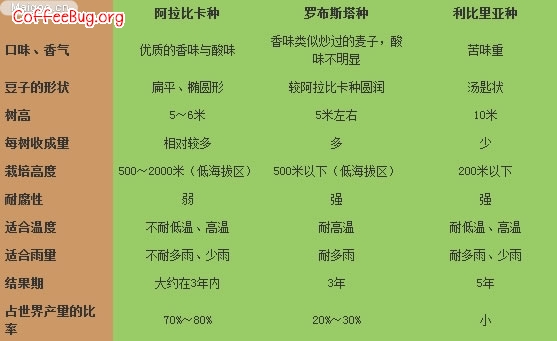
Cultivation conditions of Coffee
There is a noun called "Coffee Belt". There are more than 60 coffee producing countries in the world, most of which are located in the tropics and subtropics between the Tropic of Cancer (23 °26 'north and south). This coffee growing area is called a "coffee belt" or "coffee area" (Coffee Zone).
The annual average temperature of the coffee belt is above 20 ℃, because the coffee tree is a tropical plant and cannot grow normally if the temperature is below 20 ℃.
1. Climatic conditions
Arabica coffee is not resistant to high temperature and humid climate, nor can it stay at a low temperature below 5 ℃ for a long time, so it is planted on steep slopes of 1000 to 2000 meters above sea level. On the other hand, Robusta caffeine is adaptable (Robusta originally means "tenacious and strong") and is mostly grown in lowlands below 1000 meters above sea level.
The average annual rainfall of 1000 mm to 2000 mm, coupled with moderate sunshine, is the most suitable environment for coffee growth. However, Arabica coffee is not resistant to strong sunlight and extreme heat, so it is suitable for growing in terrain prone to morning fog, especially where there is a large temperature difference between day and night. In addition, some places will plant shelter trees in order to avoid direct sunlight, such as bananas, maize, mango trees and so on.
two。 Soil quality
To put it simply, the soil suitable for growing coffee is fertile volcanic soil with enough moisture and moisture, and rich in organic matter. The Ethiopian plateau is covered with this kind of volcanic weathered soil, so the soil rich in humus is naturally one of the basic conditions for growing coffee.
In fact, the main coffee-producing areas in the highlands of Brazil (called "Terra rossa", meaning fertile red soil weathered by basalt), the highlands of Central America, around the Andes of South America, the African highlands, the West Indies, Java (some of the soils are also weathered by volcanic rocks, or a mixture of volcanic ash and humus), and the Ethiopian highlands, have fertile soils with plenty of water.
Soil has a subtle effect on the taste of coffee. For example, the acidity of coffee grown on slightly acidic soil will also be strong; for example, the soil around Rio de Janeiro in Brazil has an iodine flavor, and the coffee will also be contaminated with that unique flavor by shaking the fruit to the ground when picking coffee beans.
3. Topography and height
It is generally believed that the coffee produced in the highlands is of better quality. Coffee-producing countries in Central America will use "elevation" as the grading standard because there are mountains crossing from the center of the continent. For example, SHB (Strictly Hard Bean) in Guatemala, the highest of the seven grades, is called SHB, which represents that its producing area is about 1370 meters above sea level.
Although the coffee farm is located on steep slopes and is not convenient for transportation, transportation, cultivation and management, this terrain has low temperatures and is prone to morning fog, which can ease the strong sunshine peculiar to the tropics and allow time for the coffee fruit to fully mature.
However, high-grade coffee such as "Blue Mountain" and "Hawaiian Kona" on the island of Jamaica are not harvested in the highlands. Because as long as there is the right temperature, rainfall and soil, there will be morning fog and a large temperature difference between day and night, high-quality coffee can be grown. It can be seen that even if "high real estate equals high quality", it does not mean that "low real estate equals low quality". Elevation can only be regarded as one of the reference criteria for judging the grade of coffee. Although elevation is important, the topography and climatic conditions of the producing area are more important.
European countries, the main consumer of coffee, gave high praise to highland coffee such as Kenya and Colombia a long time ago. Quantitative coffee beans can extract more coffee liquid (that is, higher concentration), which is one of the reasons why Highland Coffee is well received.
In addition, as mentioned earlier, Robusta coffee, which is native to the Congo, is grown in the lowlands below 1000 meters above sea level. Unlike Arabica, it grows fast and is resistant to diseases and insect pests, and can be grown in non-fertile soil. Therefore, the taste and aroma are far inferior to Arabica coffee.

The cultivation process of Coffee
People often mistakenly think that coffee is grown directly with raw beans, but it takes a long time to grow coffee only to find that it doesn't sprout. In fact, coffee is grown with seeds with endocarp (Parchment). "Inner fruit" (or "sheepskin" or "paper skin") refers to the tea-brown hard skin that wraps the coffee seeds, and the coffee beans attached to that layer are called "Parchment Bean".
Plucking the skin of the fully ripe bright red coffee fruit (called red cherry), you can see that there is yellow flesh under the red skin, which is a bit like a cherry, the flesh is sweet, there is a pair of symmetrical seeds in the center, and there is a slippery film around the seeds. Wash the film off with water to become "shelled beans". Peel off the endocarp and you will see the seeds covered with Silver Skin. The seed is the raw bean actually used as the raw material of coffee.
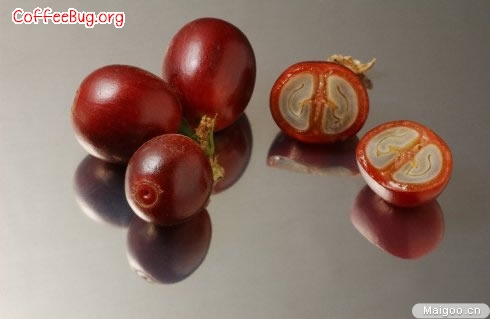

1. Sowing seeds
The coffee wrapped with endocarp will be planted in the seedbed (a plastic flowerpot called "pot") and will germinate in 40 to 60 days and grow to about 50 centimeters in about 6 months after germination. At this stage, the seedlings are still fragile and must be covered with cold gauze and other things to block direct sunlight.
The seedlings blossomed about three years after they were transplanted from the seedbed to the garden. During this period, countries such as Central America that use hand-picking to harvest coffee beans will prune the branches of coffee trees and remove the lower side branches in order to improve the efficiency of harvesting coffee. The flowers of the coffee tree are white five-petal flowers with a jasmine scent. The flowers wither in a few days, then grow small fruits, and turn red in 6 to 8 months to represent maturity.
The peak of the coffee harvest is in the 6-10 years after the coffee tree grows, and then the harvest will gradually decline. In addition, if the coffee tree grows too high, it will also lead to a poor harvest, so coffee farmers will cut off the trunk from 30cm to 50cm above the ground, allowing it to regenerate branches and renew productivity. This step is called "Cutback". If combined with climate, fertilization, resistance to diseases and insect pests and other favorable conditions, coffee trees can last 20 years, or even 50 years of continuous fruit.
Wild coffee trees can be as high as 10 meters, but generally planted coffee trees are maintained at a height of about 2 meters in order to harvest conveniently. Arabica coffee varieties are being improved year after year, hoping to reach the level of high harvest, high virus resistance, early harvest, strong environmental adaptability, and, of course, the appropriate height of trees to make harvesting more efficient.
two。 Harvest
The harvest time and method of coffee vary from place to place, generally speaking, about once or twice a year (sometimes up to three or four times). The harvest time is mostly in the dry season. In Brazil, for example, around June, it starts in the north-eastern state of Bahia and ends in October in the southern state of Parana. The harvest period of Central American countries is from September to January of the following year, from lowlands to highlands.
Harvesting methods can be divided into two categories, one is hand picking method, the other is shaking method.
(1) hand picking
With the exception of Brazil and Ethiopia, most Arabica coffee-producing countries are harvested by hand. Hand picking involves not only picking ripe bright red coffee fruits, but also sometimes along with immature cyan coffee fruits and branches, so these immature beans are often mixed with refined coffee beans, especially when refined by natural methods. If these beans are mixed with baking, they will produce a disgusting stench.
(2) shake-down method
This method is to hit the ripe fruit or shake the coffee branch with a random stick, so that the fruit falls and accumulates into a pile. Larger estates will use large harvesters, while small and medium-sized farms will harvest with a sea of people mobilized by the whole family. This method of shaking the fruit off the ground is easier to mix with impurities and defective beans than the hand-picking method, and beans from some places can be stained with a strange smell or fermented because the ground is wet. Producers of Robusta coffee beans such as Brazil and Ethiopia are mostly harvested in this way.
Countries harvested by shaking and falling method also use natural drying method to refine coffee beans. Coffee blossoms in spring, bears fruit in summer and harvests in winter, so it is very difficult to harvest and dry in places where there is no clear distinction between drought and rainy seasons. in the rainy season, it is impossible to use natural drying. Therefore, coffee is suitable for growing in areas with distinct dry and rainy seasons.
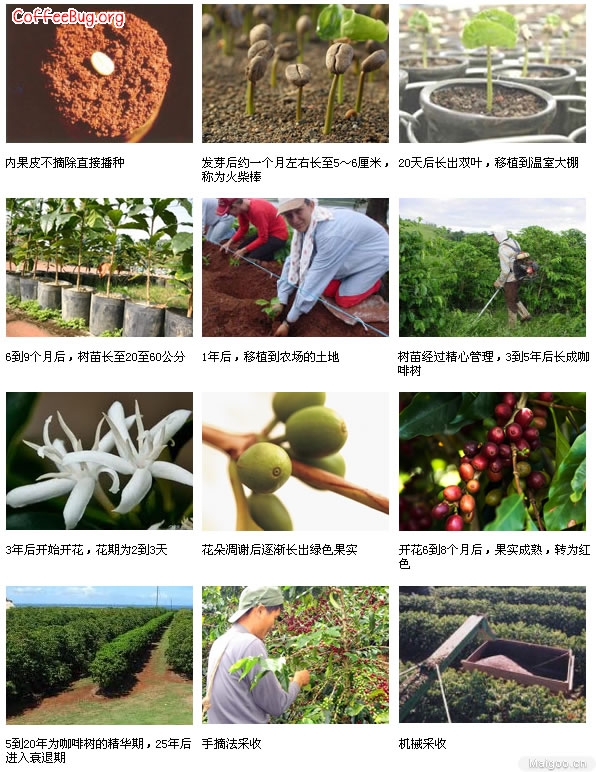
The grading of coffee
If the owner of two cafes is discussing, owner A says, "the coffee beans we use in our shop are NO.2 in Santos, Brazil. What about your store?" owner B said, "We use Brazilian NO.1 of the same grade as Blue Mountain NO.1."
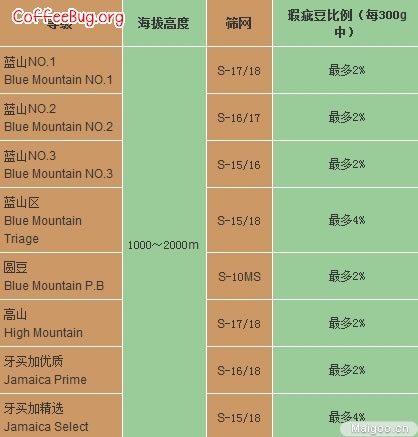
The evaluation method adopted in Brazil is the "deduction method", which is classified according to the number of defective beans per 300g of staple beans, with a total of seven grades from NO.2 to No.8, and a deduction of less than 4 is classified as NO.2 (NO.8 deduction is 360). What does not have a single defective bean can of course be called NO.1, but this situation is so rare that a certain supply cannot be maintained, so Brazil sets NO.2 as the highest level, not NO.1. From this, we know that shopkeeper B is pretending to be a forced offender.
Coffee-producing countries have their own grading methods and quality evaluation criteria in order to grade their harvested coffee (there are also countries that do not have a unified export specification, like Yemen, which produces the famous coffee mocha Matali). If the common evaluation criteria of coffee producing countries around the world, it would be much more convenient for buyers, but unfortunately, the current classification criteria are still based on the national conditions of each producing country.
Having said that, we can still roughly distinguish according to the following three points.
(1) grading according to the altitude of the place of origin
(2) grading according to the sieve (size of raw beans)
(3) grading according to the proportion of screen and defective beans.
1. Evaluate the quality by the altitude of the producing area
As mentioned earlier, the quality of high real estate coffee is better than that of low real estate, so the height of origin is also included in one of the quality evaluation criteria. The higher the altitude and the lower the relative temperature, the coffee fruit can ripen slowly, so the fully ripe beans have good expansibility and are easy to bake. As a result, coffee-producing countries in Central America evaluate the quality of coffee beans almost exclusively by the altitude of their origin.
For example, coffee from Guatemala, the highest quality coffee in the country, is called SHB, an acronym for Strictly Hard Bean, and is grown at an altitude of more than 1350 meters. The same is true of Mexico, where the highest quality SHG (Strictly Hard Grown) is grown in highlands above 1700 meters above sea level. SHG in El Salvador and Honduras is also grown in highlands above 1200 meters above sea level.
If coffee is planted on a flat plateau like Brazil, it can be mechanized on a large scale, but the main cultivation areas of coffee in China and the United States are on the slopes of hills, so it is difficult to use mechanized farming. It is said that there are even dangerous slopes with a slope of more than 40 degrees in the Blue Mountain area of Jamaica.
Planted in that place, ripe and red fruits can only be picked carefully by hand. Although the cost is high, high-quality coffee with few impurities and defective beans can be produced.
Quality and grading of Guatemalan coffee beans
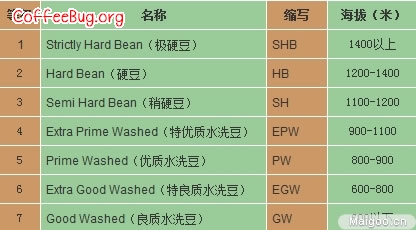
two。 Evaluate the quality by sieve
Countries that use sieves to evaluate quality include Kenya, Tanzania, Colombia and other Colombian producers of fresh and bright coffee (one of the types of coffee traded on the New York Futures Exchange based on origin). The so-called judging quality according to the screen means to evaluate the quality according to the size of raw beans. For all kinds of raw beans, the size of the beans is determined by a perforated iron plate screen.
The size of the hole in the sieve is 1 canopy 64 inches, so the 17 sieve refers to 17 canopy 64 inches, which means that the raw bean can pass through the sieve with a hole diameter of 6.75 mm. Beans larger than this size cannot pass through the sieve, and small ones can pass through, so the larger the number of the sieve, the bigger the particles of the beans.
The finest coffee beans in Tanzania are large granulated beans called AA, which need a sieve of more than 18 millimeters, while AA in Kenya also uses large granulated beans with holes above 7.2mm. Colombia has two grades: Supremo and Excelso. The special grade needs a sieve of more than 17, and the upper grade needs a sieve of 14 and 16 (refers to the beans with sieve 16 mixed with 11% of 14 sieve beans).
Large granulated beans are more varied in taste than small ones. Depending on the size of the screen, the beans sifted do make a difference in taste.
3. Evaluate the quality according to the proportion of screen and defective beans.
Then there is Brazil, a big coffee country, which uses three grading methods: defective bean proportion (deduction method), sieve mesh, and taste test, to derive the third evaluation method. For example, when you buy Brazilian coffee beans, you will see the sign "Brazil Santos NO.2,19 sieve, very mild (Strictly Soft)", which is described as follows:
Brazil-name of the producing country
Santos-export port
NO.2-- represents the grading of the number of defective beans mixed in, NO.2 is the highest grade, and NO.8 is the lowest limit of output sales specifications.
Sieve No. 19-indicates the size of the beans. Brazil means 12-20. The larger the number, the bigger the particles. 19 represents beans that pass through a 7.54 mm hole sieve. However, this grading method is limited to flat beans, and round beans should be graded with a special oval mesh (8-13).
Extremely mild-indicates the grading of Cup Testing, and extremely mild means the highest level.
Brazilian cup test classification method:
Grade 1:Strictly Soft (very mild)
Grade 2:Soft (mild)
Grade 3:Softish (slightly mild)
Level 4:Hard (difficult)
Grade 5:Rio (light iodine flavor)
Grade 6:Rioy (strong iodine flavor)
The grade 1-3 here is collectively referred to as "mild", with a balance of sweetness, bitterness and sour taste. On the contrary, grades 5 and 6 are inferior products with iodine odor. The soil around Rio de Janeiro in Brazil has a strong smell of iodine, and when the coffee fruit falls on the soil, it will be stained with a unique flavor.
Brazil's three-stage classification system has not been adopted in other countries because it is not necessary. In other words, even if you don't need a cup test, you can know that these coffees have a certain quality. Brazil adopts this "cup test grading method" because the production area is too large and produces too many beans, and these coffee beans are often mixed in order to make the special coffee flavor for export, so it is necessary to use "cup test" classification in the case of different quality.
For this reason, coffee appraisers in Brazil must comply with strict requirements: in order to fully operate their sense of taste and smell when identifying coffee, they should not eat leeks, onions, garlic and other foods that paralyze their tongues in addition to tooth decay. Tobacco, alcohol and strong perfumes are also prohibited. There are often stone pillars in front of the Zen temple that "meat and wine are prohibited from entering the mountain gate". The "meat wine" here refers to leeks, green onions and other strong flavor of green vegetables and wine. Caffeine appraisers in Brazil, like Zen monks, are vegetarian every day.
In addition to the three classifications mentioned above, cultivated land classification is used in some areas, like Jamaica.
There are different ways of grading in different producing countries, and it takes a little skill to remember them all, but it's no big deal after you get familiar with it. In a word, "large granulated coffee beans are good beans in the highlands without defective beans."
Quality and grading of Brazilian coffee beans (deduct points according to the amount of defective beans and impurities mixed in every 300g coffee beans, and then divide the beans into NO.1~NO.8 depending on the deduction)
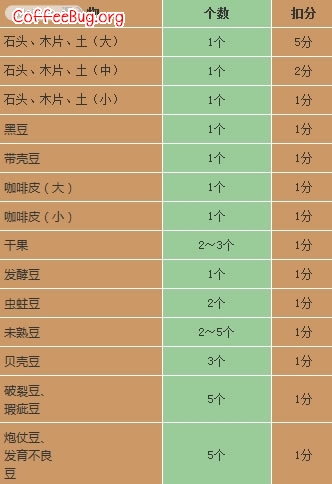
- Prev

Coffee drinking rules for beginners
1. How do I get a coffee cup? Coffee after meals is usually served in a pocket-sized cup. The ears of this cup are too small for fingers to pass through. But even if you use a larger glass, don't put your finger through the ear before holding it. The correct way to hold a coffee cup should be to pinch the cup handle with your thumb and index finger and then lift the cup. 2. How do I sweeten my coffee? When adding sugar to coffee, sand
- Next

The type of coffee
First, Brazil (South America) Santos coffee: taste mellow, neutral, can be directly boiled, or mixed with other kinds of coffee beans into a comprehensive coffee, is also a good choice. Second, Columbia (South America) Manning: the palate is rich and solid, with a pleasant sour taste. The smell is mellow, the acidity is moderate, the sweetness is rich and intriguing, it is suitable for deep baking and exudes a strong aroma.
Related
- Beginners will see the "Coffee pull flower" guide!
- What is the difference between ice blog purified milk and ordinary milk coffee?
- Why is the Philippines the largest producer of crops in Liberia?
- For coffee extraction, should the fine powder be retained?
- How does extracted espresso fill pressed powder? How much strength does it take to press the powder?
- How to make jasmine cold extract coffee? Is the jasmine + latte good?
- Will this little toy really make the coffee taste better? How does Lily Drip affect coffee extraction?
- Will the action of slapping the filter cup also affect coffee extraction?
- What's the difference between powder-to-water ratio and powder-to-liquid ratio?
- What is the Ethiopian local species? What does it have to do with Heirloom native species?

